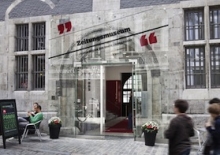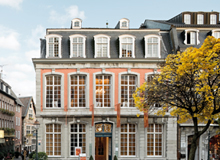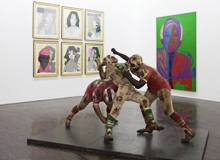The ground floor features sculptures from the 12th to 16th century. These are housed in the Sculpture Rooms, which are accessed through the Fireplace Room and via a ramp. The exhibition encompasses majestic cathedral sculpture from France, evocative representations of the Madonna from 14th- and 15th-century Cologne, and the dramatic works of Master Tilman, Arnt van Tricht and Henrick Douwermann from the Lower Rhine. The rear rooms display East German, South German and Alpine sculptures, for example the two, large, fully intact framed altarpieces, the Swabian Altar of Mary from around 1510, and the Saxon Altar of the Holy Kinship (1511). Works by woodcarvers like Daniel Mauch and Hans Multscher have earned the museum international prestige.
The arrangement of works exhibited in the so-called Vaulted Room reflects their original functional context in a church. The Geldrian Altar of St Peter (circa 1500), for example, is surrounded by medieval implements and cult figures, including a Cologne Madonna from 1180.
In 1994, the French artist Christian Boltanski (1944-2021) arranged files from the museum archives in a wooden rack in the Suermondt Ludwig Museum, illuminated by twelve incandescent lamps.
Exploration of the past and the principle of archiving play a key role in Boltanski's installation art. By disrupting the system of the files, he is – as it were – attacking their meticulous principle of order.
This installation has remained to this day a "living" work of art, in the sense that the files in it continue to be used.
Aachen's citizens have accumulated an astounding collection of curiosities. A selection of them can be viewed in the Civic Cabinet of Arts and Curios. Many 19th-century collectors aspired to display the world in its entirety, and so they collected objects from all domains. Found natural objects were placed on a par with man-made works of art; fossils next to Greek vases, replicas next to originals. The prime endeavour was completeness, not necessarily authenticity. The inspiration came from the "Kunstkammer" and "Wunderkammer" maintained by rulers, lords and scholars of the Renaissance and the Baroque era. They were a demonstration of the power and wealth of their owners, and reflected the current state of knowledge of the world and of the order of things – world expositions en miniature, so to speak.
The exhibition room to the side begins with panel paintings of the Cologne School, including an Adoration of the Magi by the Master of the Glorification of the Virgin as well as Southern German and Early Dutch works, for example Albrecht Bouts' impressive diptych of Christ and Maria. The large room on the opposite side of the staircase landing offers a view of paintings of the Italian and Spanish medieval and Baroque periods. The large painting by Jusepe de Ribera, the Adoration of the Shepherds, is flanked by outstanding works of Francisco Zurbarán, Bartolomeo Manfredi, Tintoretto and Luis de Morales.
A doorway leads into the Tapestry Room, which displays Brussels tapestries from the Late Renaissance and Baroque period. This room also houses the rich collections of antiquities whose mythological themes were repeatedly taken up again by later painters and tapestry weavers.
The rear side of the staircase landing leads to the Skylight Rooms, beginning with two rooms displaying German and Dutch panel paintings and winged altarpieces of the 15th and 16th centuries. Here, visitors can marvel at the works of Ambrosius Benson, the Master of Delft, and Derick Baegert as well as works by followers of Hans Memling and from the workshop of Lucas van Leyden. While Lukas Cranach's Judith with the Head of Holofernes still portrays a contradictory world in turmoil, the works of Joos van Cleve, the so-called Leonardo of the North, and the small painting of Mary Magdalene and John the Baptist by Cornelis Engebrechtsz already presage the worldly view of the Renaissance.
The third room on the first floor and the rear staircase landing display large paintings by Dutch and Flemish artists of the 17th century, for example the Fall of the Damned by the Rubens pupil Jan Boeckhorst, Jacob Jordaens' Feeding of the Infant Jupiter, Frans Snyders' allegorical rooster painting as well as works by Frans Francken, David Teniers and the Brueghel family.
In the Cabinet Rooms that surround the rear staircase, visitors can discover further works of Dutch painting from the Golden Age. Among the abundance of works of all genres, which are ordered according to the topics favoured, superlative masters stand out, for example Rembrandt with his Portrait of a Young Man, and a number of Rembrandt pupils like Anthonis van Dyck, Joseph de Bray or Frans Hals. In terms of art history, the highlights are the still lifes by Willem Claesz Heda and Willem Kalf, the landscapes by Jacob van Ruisdael and Jan Vermeer van Haarlem, or Esaias Boursse's Boys Blowing Bubbles.
The exhibition of paintings of the Biedermeier period is introduced with Johann Baptist Bastiné, a pupil of Jacques-Louis David, and continues with idyllic scenes by the Munich artist Carl Spitzweg. One of the main focuses of the collection of Late Romanticism in the second half of the 19th century is the work of the Düsseldorf School with artists from the circle of Oswald and Andreas Achenbach and Ludwig Scheins. The transition into the 20th century is illustrated with a major work by Max Liebermann, one of the leading proponents of German Impressionism.
Classical Modernism is represented in the Suermondt Ludwig Museum by internationally renowned artists like Alexej von Jawlensky and Lovis Corinth. In addition, the exhibition also makes a point of devoting attention to regional or at times forgotten artists like Walter Ophey, Barthel Gilles, Heinrich Maria Davringhausen and Hanns Bolz. The transition from Expressionism to free, abstract use of colour is reflected in the paintings by Ernst Wilhelm Nay. Together with Karl Otto Götz, Nay counts as one of the most important artists of the German avant garde of the 1950s.
In addition, the second floor also houses works of glass painting. The exhibition allows visitors to trace the technical and stylistic development of these early works through to significant stained glass windows of the 20th century.

Medienmuseum, Wechselausstellungen und eine Sammlung von 200.000 Zeitungen und Druckwerken in nahezu allen Sprachen.

Das bekannteste Wohnzimmer Aachens, mit anschaulichen Einblicken in die Wohnkultur des 18. und frühen 19. Jahrhunderts.

UNESCO-Weltkulturerbe mit herausragender künstlerischer Ausstattung: Karlsschrein, aufwändigen Mosaiken, einer goldenen Altartafel.

Die größten Historienbilder der Romantik, originalgetreue Kopien des Säbels Karls des Großen, einer karolingischen Handschrift, der Reichskrone.

Kunst von der Gegenwart bis in die Antike, mit hervorragenden Gemälden und Skulpturen des Spätmittelalters sowie der Malerei des 17. Jhs.

Schauplatz für zeitgenössische Künstler und Kunstwerke, Begegnungsstätte darstellender und bildender Kunst, Bestände der Sammlung Ludwig.

Lebendiges Zentrum zur Erinnerung der Grenzgeschichte und -geschichten, mit verbotenen Souvenirs und Schwarzbrennerei.

Eröffnung 2014 – Lebendige Geschichte von den Karolingern bis heute. Ausgangspunkt der Route Charlemagne am historischen Katschhof.

Stolz blicken die Aachener auf ihre Geschichte als römische Bäderstadt und Kaiserresidenz Karls des Großen zurück. Der Dom, 1978 zum ersten UNESCO Weltkulturerbe in Deutschland ernannt, und das Rathaus bilden den Mittelpunkt der Stadt. In den Gassen der Altstadt erzählen viele historische Gebäude von der lebhaften Geschichte der Stadt, und doch ist die Zeit nicht stehen geblieben.
An der „Eliteuni“ RWTH Aachen und den anderen Hochschulen sind rund 40.000 Studenten eingeschrieben. Das junge Leben pulsiert vor allem im Pontviertel, dem beliebten Ausgehviertel mit seinen zahlreichen Cafés, Kneipen und Restaurants. Doch auch in den Gassen und auf den Plätzen der Altstadt ist immer viel los. Rund um Dom und Rathaus laden zahlreiche Einzelhändler ebenso wie Filialen namhafter Häuser zum Bummeln ein.
Quelle allen Ruhms ist das Wasser: Die Heilkraft der heißen Thermalquellen war ausschlaggebend dafür, dass Kaiser Karl Aachen zu seiner Lieblingsresidenz machte. Die Badetradition wird heute durch die Carolus Thermen Bad Aachen weitergeführt.
Wer sich lieber in der Natur entspannt, hat dafür zahlreiche Möglichkeiten, etwa im nahe gelegenen Nationalpark Eifel. Zudem locken mehrere Theater und Museen mit einem vielschichtigen Angebot.

